Runtime Linking

Quick Navigation:
- Runtime Linking Definition
- Runtime Linking Explained Easy
- Runtime Linking Origin
- Runtime Linking Etymology
- Runtime Linking Usage Trends
- Runtime Linking Usage
- Runtime Linking Examples in Context
- Runtime Linking FAQ
- Runtime Linking Related Words
Runtime Linking Definition
Runtime linking is a dynamic method of resolving dependencies in a software program while it is executing, rather than at compile time. This process allows programs to load libraries, modules, or dependencies only when they are required, enhancing flexibility and reducing memory usage. Runtime linking is essential in operating systems, shared library management, and plugin architectures, enabling seamless updates and modular software design.
Runtime Linking Explained Easy
Imagine you're building with LEGO blocks, but instead of putting all the pieces together before you start playing, you add the pieces only when you actually need them. This way, you don’t waste time or space keeping unnecessary blocks. Runtime linking works similarly in software: it loads parts of the program only when they're needed, making the software more efficient.
Runtime Linking Origin
The concept of runtime linking emerged with the development of operating systems that supported dynamic libraries, allowing software to become more modular. It became more prominent with the rise of shared libraries in UNIX and Windows environments, reducing redundant code across multiple programs.
Runtime Linking Etymology
The term "runtime linking" is derived from "runtime," referring to the period when a program is executing, and "linking," which refers to the process of connecting different code modules or libraries together.
Runtime Linking Usage Trends
With the increasing complexity of modern applications, runtime linking has become a crucial technique in software engineering. It is widely used in plugin-based software, game development, and cloud applications to optimize performance and enable updates without requiring full recompilation.
Runtime Linking Usage
- Formal/Technical Tagging:
- Dynamic Linking
- Shared Libraries
- Dependency Resolution - Typical Collocations:
- "runtime linking mechanism"
- "dynamic library loading"
- "on-demand module linking"
- "runtime dependency resolution"
Runtime Linking Examples in Context
- A web browser loads plugins using runtime linking, allowing users to enable or disable features without restarting the browser.
- Video games use runtime linking to load different game assets and levels dynamically, reducing initial loading times.
- Operating systems use runtime linking to share common system libraries across multiple programs, saving memory and improving efficiency.
Runtime Linking FAQ
- What is runtime linking?
Runtime linking is the process of dynamically loading libraries or modules into a program while it is running. - How does runtime linking differ from static linking?
Static linking incorporates all dependencies at compile time, while runtime linking loads them only when needed. - What are the advantages of runtime linking?
It reduces memory usage, allows modular software design, and enables updates without recompiling the entire program. - Is runtime linking used in all software applications?
No, some applications use static linking for simplicity and performance reasons, but many modern applications rely on runtime linking. - How does runtime linking affect application security?
While it allows for flexible updates, improper implementation can introduce security vulnerabilities like DLL hijacking. - Can runtime linking improve application performance?
Yes, by loading only necessary modules, runtime linking can optimize memory usage and reduce startup time. - What programming languages support runtime linking?
Many languages, including C, C++, Python, and Java, support runtime linking through dynamic libraries. - How do operating systems handle runtime linking?
OSs provide mechanisms like DLLs (Windows) and shared objects (Linux) to facilitate runtime linking. - Can runtime linking cause compatibility issues?
Yes, if different versions of a library are used, it may lead to unexpected behavior or crashes. - How do developers troubleshoot runtime linking issues?
Tools like dependency walkers, dynamic link analyzers, and debugging logs help diagnose linking problems.

Runtime Linking Related Words
- Categories/Topics:
- Software Development
- Operating Systems
- Dynamic Linking
Did you know?
Early versions of Windows used static linking, which made updates cumbersome. Runtime linking was later introduced to allow for more efficient system updates and application compatibility without requiring entire software reinstallation.
PicDictionary.com is an online dictionary in pictures. If you have questions or suggestions, please reach out to us on WhatsApp or Twitter.Authors | Arjun Vishnu | @ArjunAndVishnu

I am Vishnu. I like AI, Linux, Single Board Computers, and Cloud Computing. I create the web & video content, and I also write for popular websites.
My younger brother, Arjun handles image & video editing. Together, we run a YouTube Channel that's focused on reviewing gadgets and explaining technology.



Comments powered by CComment